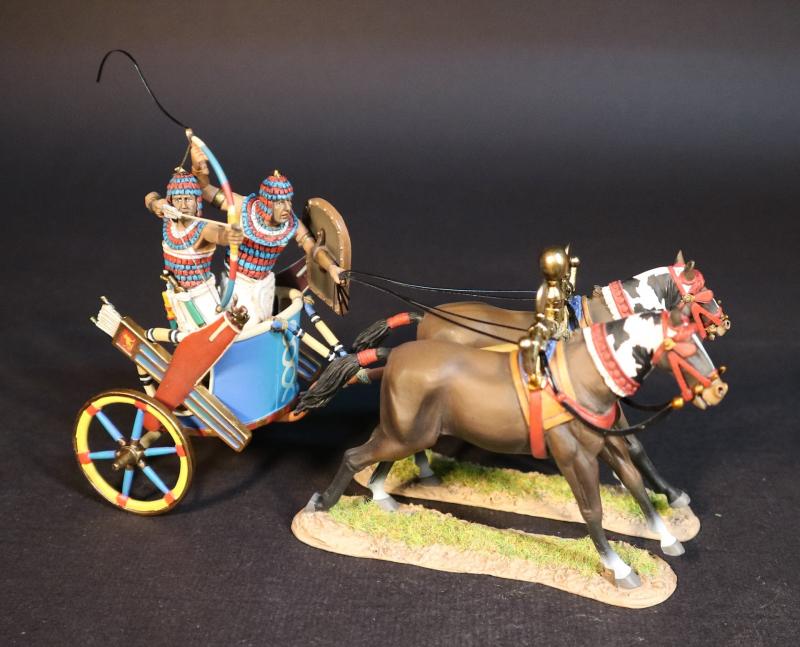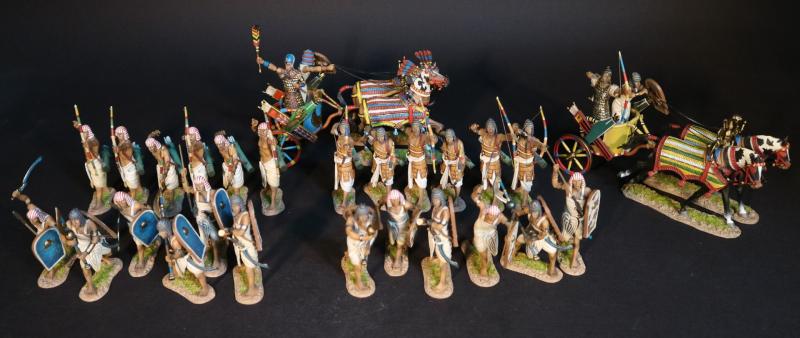Egyptian War Chariot, The Battle of Kadesh, 1274 BCE, New Kingdom Egyptians, The Ancients--archer figure, driver figure with whip and shield, two horses, chariot
$318.00
Item Number: NKE-03
Egyptian War Chariot, The Battle of Kadesh, 1274 BCE, New Kingdom Egyptians, The Ancients
THE ANCIENTS
NEW KINGDOM EGYPTIANS
The New Kingdom, is the period in ancient Egyptian history between the sixteenth century BCE and the eleventh century BCE. It was Egypt’s most prosperous time and marked the peak of its power.
It is also known as the “Ramesside period”, named after the eleven pharaohs who took the name Ramesses, after Ramesses I, the founder of the nineteenth Dynasty
Ancient Egyptian chariots, emblematic of the power and prestige of the New Kingdom period (c. 1550-1070 BCE), were an integral part of the military and cultural fabric of the time. These fast-moving, lightweight vehicles revolutionized warfare, enabling pharaohs to project their might and influence over vast territories.
The development of chariots began in the Near East around 3000 BCE, with the earliest known examples originating from Sumer in Mesopotamia.
The introduction of chariots to Egypt occurred during the Second Intermediate Period (c. 1650-1550 BCE), a time marked by the decline of the Middle Kingdom and the fragmentation of Egyptian power.
During this period, the Hyksos, a Semitic-speaking people from Western Asia, migrated to and settled in the Nile Delta. They eventually established their rule over the northern part of Egypt, creating the 15th Dynasty.
The Hyksos brought with them advanced technology and innovations, including the horse-drawn chariot and the composite bow. These technological advancements provided them with a significant military edge, enabling them to maintain control over their newly acquired territories.
As they assimilated into the local culture, they also introduced these innovations to the Egyptian population.
The Egyptian elite adopted the chariot as a symbol of power, prestige, and divine favor.
Under the reign of Ahmose I (c. 1539-1514 BCE), the founder of the 18th Dynasty and the New Kingdom, the Egyptians successfully drove the Hyksos out of Egypt. This victory was partly due to their effective use of chariots, which allowed them to match and surpass the Hyksos in battle.
In the New Kingdom, the Egyptian chariots were further refined and optimized for their specific needs. They became lighter, faster, and more maneuverable, with a design that prioritized the use of archers in battle. They were typically made from wood, with some parts fashioned from leather and bronze.
The yoke and harness system connected the chariot to the horses. The yoke was a wooden crossbar placed across the necks of the horses, with a central pole extending from it to the chariot.
The overall design of ancient Egyptian chariots made them highly efficient and agile vehicles that revolutionized warfare in the region.
In battle, chariots were primarily employed for offensive purposes, functioning as mobile archery platforms, and were also used for pursuing fleeing enemies, ensuring a decisive victory.
The golden age of the Egyptian chariot coincided with the New Kingdom (c. 1550-1070 BCE), a period marked by the resurgence of Egyptian power and the expansion of its empire.
These versatile vehicles enabled Egypt's New Kingdom pharaohs to project their power across vast territories and solidify their status as rulers of a mighty empire.
Today, the chariot remains an enduring symbol of ancient Egypt's military prowess and cultural sophistication.
The Battle of Kadesh took place between Ramesses II, Egyptian Empire and the Hittite Empire led by Muwatalli II, in what is believed to be around May 1274 BCE. The battle took place at the Orontes River, just upstream of Lake Homs and near the archaeological site of Kadesh, along what is today the Lebanon-Syria border.
It is the earliest pitched battle in recorded history for which details of tactics and formations are known, and is believed to be the largest chariot involved battle ever fought. It is believed there were between 5,000 to 6,000 chariots involved in total.
In the critical moment of the battle, Ramesses and his body guard were surrounded, and he broke out by personally leading several charges into the Hittite ranks.
Box Size: 10 ¾” x 9 ¼” x 5”
Released in MAY 2024.

